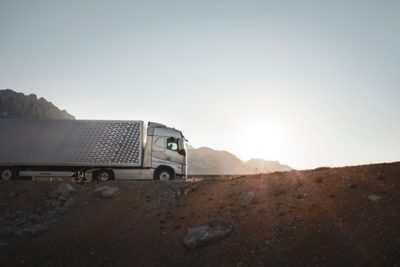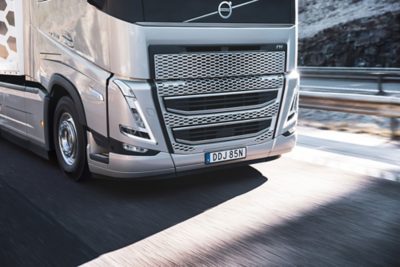Rezistența aerodinamică are un impact major asupra eficienței combustibilului camionului dumneavoastră, mai ales atunci când acesta se deplasează la viteze care depășesc 50 km/h. Cheia pentru reducerea acestui impact și scăderea costurilor cu combustibilul este înțelegerea modului în care funcționează aerodinamica camioanelor.
Cum afectează aerodinamica eficiența combustibilului?
Când un camion “străpunge” aerul, acesta întâmpină o rezistență aerodinamică semnificativă - forța exercitată de aer. În timp ce rezistența aerului apare la orice viteză a vehiculului, relația sa cu viteza nu este proporțională. Deci, atunci când viteza se dublează, rezistența aerului crește de patru ori. Dacă viteza se triplează, rezistența crește de nouă ori și așa mai departe.
Acest lucru are un efect dramatic asupra eficienței energetice a unui camion greu, mai ales atunci când se deplasează cu viteză mare pe o autostradă. De fapt, rezistența aerului poate reprezenta până la o treime din pierderile de combustibil pentru un transport pe distanțe lungi cu un camion diesel. Pentru camioanele electrice cu baterie, pierderile de energie pot fi de până la 50%. Prin urmare, aerodinamica unui camion are una dintre cele mai mari influențe directe asupra eficienței consumului de combustibil. Care, la rândul său, are un impact asupra mediului.
Înțelegerea fluxului de aer al camionului și cum poate fi redusă rezistența aerodinamică
Pentru a reduce impactul rezistenței aerului, este importantă întârzierea sau reducerea separării fluxului de aer. Acesta este momentul în care un strat de flux de aer se desprinde de pe suprafața camionului și devine extrem de turbulent. Cu cât se detașează mai devreme, cu atât este mai mare traseul în spatele camionului și, prin urmare, cu atât rezistența la presiune este mai mare.
O modalitate de a reduce separarea fluxului de aer este de a sigila golurile din partea din față a camionului, acolo unde este posibil. Colțurile din față în special sunt o zonă sensibilă în care chiar și golurile mici pot provoca desprinderea aerului, creând un impact semnificativ asupra fluxului general de aer.
„Când fluxul de aer se apropie de colțul unui camion, gândiți-vă la el ca la o plimbare cu caruselul. Trebuie să te ții bine pentru a rămâne pe poziție atunci când urmează curbura. Este același lucru cu fluxul de aer, cu excepția faptului că nu are mâini cu care să se prindă de o suprafață, așa cum am face-o noi. Pentru a rămâne atașat, aerul trebuie să folosească presiune scăzută”, spune Anders Tenstam, specialist în tehnologie aerodinamică, Volvo Trucks.
Completarea golurilor din partea din față a camionului deschide, de asemenea, alte domenii de îmbunătățire, cum ar fi extensiile mai lungi ale ușilor pentru a reduce golul din zona treptelor. Acest lucru întârzie separarea fluxului, deoarece aerul are o suprafață plană de care să se atașeze.
Același principiu se aplică și pentru apărătoarele de aripă care reduc distanța deasupra roții. Oglinzile camionului pot fi, de asemenea, îmbunătățite cu linii curbe și găuri mai mici, iar camerele video, în loc de oglinzile actuale, vor reduce zona frontală a camionului, rezultând o rezistență aerodinamică mai mică.
The importance of specifying your truck with cab roof and side deflectors
The roof deflector is the most important aerodynamic device for reducing fuel consumption. It does depend on the type of operation, but many truck businesses will benefit from a roof deflector, provided it is selected and fitted to suit the trailer configuration. Ensuring the optimum height is crucial - recent findings based on simulations at Volvo Trucks indicate that it can save between two to six percent* in fuel if it is set correctly.
The type of trailer used in your daily operations will also have an impact on how your aerodynamic fittings work and how much fuel or energy you can save. For example, when combined, simulations show that the cab roof deflector and cab side deflectors can lower fuel consumption by as much as four to five percent* on a typical long-haul operation.
For operations with different types of trailer configurations, the amount of fuel you can save will vary, but the cab roof and side deflectors will still have a positive impact. This is because when the air flow is released from the back of the cab, it is sucked into the gap between the cab and the cargo, creating significant air resistance. To shelter a non-aerodynamic load from this air pattern, correctly positioned roof and side deflectors are essential.
The future of truck aerodynamics
Advances in virtual simulation have opened up new possibilities for visualising and analysing truck air flow behaviour and aerodynamics. Simulation parameters can easily be adjusted and run again and again in a short space of time. This has speeded up the verification process and lead times for aerodynamic improvements to come to market.
“It is a fast-paced and ever-growing field. You can now go into whatever detail you want on the truck to gain knowledge about air flow, and enhance aerodynamic performance,” says Mattias Hejdesten, Engineering Specialist Aerodynamics, Volvo Trucks.
The recent update to the EU weight and dimension legislation for trucks, removing the total length restriction of 16.5 metres, has also enabled more freedom when it comes to aerodynamic shape optimisation on the truck’s exterior.
“All this has changed the way truck manufacturers are working with aerodynamics, and truck businesses can expect to see more design changes in the future,” says Mattias Hejdesten.
Furthermore, aerodynamics is no longer just about reducing fuel consumption. It is about increasing energy efficiency, regardless of the type of fuel the truck is running on, to lower environmental impact.
Enhanced aerodynamics is especially important for battery electric trucks, which have less energy available. Making the right choices about fittings, and considering the aerodynamic design when specifying your truck with your supplier, is therefore one of the most important ways to optimise routes and increase range.
“As we look to the future, it is essential that trucks are as energy efficient as possible and advances in aerodynamics will have a major role to play,” says Anders Tenstam.
6 ways to improve fuel economy by optimising truck aerodynamics
- Ensure the roof deflector is at the correct height for your trailer configuration.
- Consider adding cab side deflectors to reduce aerodynamic drag.
- Where possible, adjust the roof deflector to suit the load you are carrying.
- As aerodynamic resistance increases with speed, consider reducing the average speed of your trucks if possible.
- Consider other aerodynamic fittings that can help to lower fuel consumption, such as bumper spoilers, chassis skirts and fender flares.
- Avoid truck accessories, such as bull bars, air horns and extra lights as these will increase aerodynamic resistance.
*Based on a typical long-haul diesel operation and standard trailer configuration, and extensive virtual simulations and research conducted by Volvo Trucks. Actual fuel economy may vary depending on many factors i.e. driving speed, use of cruise control, vehicle specification, vehicle load, actual topography, the driver´s driving experience, vehicle maintenance, and weather conditions.




